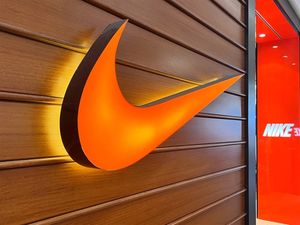
Apple's recent "Awe Dropping" launch event for its iPhone 17 lineup has sent ripples through the financial markets, presenting a complex picture of robust consumer demand clashing with a cautious investor sentiment. While early preorder data suggests a strong appetite for the new devices, particularly in key international markets, the immediate market reaction saw Apple's stock experience a dip, highlighting the delicate balance between innovation, market expectation, and the "sell-the-news" phenomenon. The event introduced several highly anticipated updates and a new ultra-thin model, yet investors appeared to be seeking a more revolutionary leap, especially in the realm of artificial intelligence.
The iPhone 17 Unveiling: What Happened and Why It Matters
On September 9, 2025, Apple (NASDAQ: AAPL) unveiled its highly anticipated iPhone 17 series at its "Awe-Dropping" fall launch event from Cupertino. The lineup, featuring the iPhone 17, iPhone 17 Pro, iPhone 17 Pro Max, and the new ultra-thin iPhone Air, aimed to showcase significant advancements. CEO Tim Cook lauded the iPhone Air as the "biggest leap ever" for the device, emphasizing its impossibly thin 5.6mm titanium frame and 6.5-inch display. Across the board, key announcements included the new A19 chip, enhanced AI features, improved cameras with all three rear cameras on Pro models at 48MP, longer battery life, and ProMotion OLED displays with up to 3000 nits peak brightness. The base iPhone 17 now starts with 256GB storage, maintaining its $799 price point, while the iPhone 17 Pro saw a $100 price increase to $1,099, and the Pro Max offered a new 2TB storage option. The event also introduced the Apple Watch SE 3, Series 11, Ultra 3, and AirPods Pro 3, notably featuring a live language translation capability, priced at $249.
Despite the "awe-dropping" moniker, some analysts found the AI enhancements to be modest, with more significant updates potentially delayed until 2026. This perception, coupled with numerous features having leaked beforehand, contributed to a lack of market surprise.
However, early preorder data painted a picture of strong consumer interest. Analyst Ming-Chi Kuo reported that first-weekend preorder demand for the iPhone 17 series was 25% higher than for the iPhone 16 preorders. Wedbush Securities echoed this, estimating a 5-10% increase, attributing it to a massive upgrade opportunity for a significant portion of Apple's user base. Notably, China saw record-breaking preorders, with sales surpassing the entire first-day volume of the iPhone 16 series within minutes on JD.com. India also showed a 30-40% jump in first-weekend pre-bookings, though inventory shortages were reported in both regions, leading to extended wait times. The iPhone 17 Pro Max showed the strongest demand, up 60% from its predecessor, while the new iPhone Air, despite its hype, had lower preorder demand than the iPhone 16 Plus it replaced, facing some delivery pauses in China due to regulatory concerns over its eSIM card.
The immediate market reaction to the launch was largely cautious and negative. Apple's stock fell following the event, dropping 1.5% on September 9, and tumbling 3.2% on September 10, ultimately shedding $56.8 billion in market value between September 9 and 12. Reasons for this dip included a "sell-the-news" syndrome, disappointment over "incremental updates" rather than "breakthrough innovation," particularly in AI, and concerns over margin pressure due to tariffs despite subtle price increases. Nonetheless, some analysts remain optimistic, pointing to the strong upgrade cycle potential, especially in China, and the company's robust brand loyalty and large installed base of older iPhones as drivers for future demand.
Goldman Sachs's Endorsement and Apple's Market Position
Goldman Sachs analysts, led by Michael Ng, have affirmed a "Buy" rating on Apple (NASDAQ: AAPL) stock with a price target of $266.00, citing "strong iPhone 17 demand signals from pre-order trends." This optimistic outlook is bolstered by extended lead times across all iPhone 17 models in key global regions, including the USA, Mainland China, Japan, the UK, India, and Hong Kong. For instance, pre-order lead times for the base iPhone 17 model were 8 days longer than its predecessor, and the iPhone 17 Pro Max saw an 8-day increase. Mainland China, a critical market, exhibited the most substantial delays, with average lead times increasing by 17 days, leading to waiting periods of up to five weeks for some models. The Pro and Pro Max variants consistently showed the longest wait times, underscoring a robust consumer preference for premium devices.
These extended lead times are particularly significant given a reported 25% year-over-year increase in production volumes for the iPhone 17 series (base, Pro, and Pro Max), and a tripling of iPhone Air production. This suggests that the actual market demand growth has outpaced Apple's supply chain capacity, reinforcing the strength of consumer interest. Goldman Sachs anticipates this robust demand will contribute to an 8% iPhone revenue growth for Apple's fiscal fourth quarter of 2025, with further growth expected from channel replenishment. The firm forecasts Apple's iPhone business revenue to grow by 5% in fiscal 2025, accelerating to 7% in fiscal 2026. This positive sentiment is further supported by strategic product line adjustments and a "stealth" pricing strategy, such as potentially making 256GB the new entry-level storage for Pro models, thereby increasing the average selling price (ASP).
While Apple itself is poised to be a primary winner if this demand translates into sustained sales, the mixed market reaction and challenges in AI integration highlight potential headwinds. Competitors like Samsung (KRX:005930) and Google (NASDAQ: GOOGL) have already made significant strides in generative AI, which could put pressure on Apple's premium positioning if its AI capabilities are perceived to lag. The high demand for the Pro Max models, despite their increased prices, indicates that consumers are willing to pay a premium for advanced features, a trend that Apple is well-positioned to capitalize on, but also one that competitors are aggressively pursuing.
Industry Impact and Broader Implications
The iPhone 17 launch occurs amidst several overarching industry trends that shape its wider significance. The smartphone market is experiencing a notable "premiumization" trend, with consumers increasingly opting for higher-priced, feature-rich devices. The premium segment (devices over $600) grew by 8% in the first half of 2025, doubling the overall market growth, and now accounts for over 60% of global smartphone revenues. This trend, driven by consumers' willingness to invest in advanced features often facilitated by financing and trade-in programs, bodes well for Apple's high-end product strategy.
However, AI integration is emerging as a critical differentiator. While Apple's "Apple Intelligence" platform processes 95% of AI tasks on-device, emphasizing user privacy, competitors like Google (NASDAQ: GOOGL) and Samsung (KRX:005930) have already integrated generative AI into their flagship devices. Apple's more advanced AI features, including an enhanced Siri, are largely anticipated for 2026, creating a temporary perception of a lag. Despite continuous innovation, the overall global smartphone market is projected to see only a modest 1% increase in unit shipments in 2025, due to challenging economic environments and consumers extending their device renewal cycles to an average of four years. This "lengthening upgrade cycle" poses a challenge to all manufacturers, including Apple, as the market's mixed reaction to the iPhone 17 highlights the difficulty in significantly shortening the current 3.6-year average upgrade cycle.
The launch intensifies competition, particularly in the high-end segment. While Apple remains dominant, its market share in the premium segment saw a slight decline from 65% in H1 2024 to 62% in H1 2025 as rivals demonstrated faster growth. Samsung (KRX:005930) secured the second-largest share with an 8% increase in shipments, effectively leveraging its "AI for all" campaign with the Galaxy S24 and upcoming Galaxy S25 series. Google (NASDAQ: GOOGL), with its Pixel series, remains a strong competitor in software and AI. Additionally, Huawei is recovering market share in China, and Xiaomi is gaining significant traction in the premium segment, growing 55% year-over-year in H1 2025. Apple is, however, projected to surpass Samsung as the world's largest smartphone manufacturer in 2025, driven by aggressive pricing and a diverse product mix. Apple has also substantially ramped up its iPhone production in India, assembling 60% more iPhones in the year ending March 31, 2025, a significant strategic shift to diversify its supply chain.
On the regulatory front, Apple is navigating a complex global landscape. The EU Digital Markets Act (DMA) has already resulted in a €500 million fine for Apple in April 2025 due to anti-steering obligations. In the U.S., a comprehensive antitrust lawsuit from the Department of Justice (DOJ) alleges monopolistic practices, with Apple's attempt to dismiss it being unsuccessful. The UK's CMA has designated Apple and Google with "strategic market status," proposing rules similar to the EU's DMA. Furthermore, regulatory concerns in China over the iPhone 17 Air's eSIM card have delayed its launch there. These escalating legal and regulatory pressures, especially concerning the App Store, pose a fundamental challenge to Apple's highly profitable services business model, with the possibility of behavioral remedies, such as a forced split between hardware and software, being a "nightmare scenario."
What Comes Next
The iPhone 17 launch sets the stage for both short-term performance and long-term strategic evolution for Apple (NASDAQ: AAPL). In the short term, the company aims to capitalize on the strong preorder demand and its incremental hardware updates to drive an upgrade cycle, particularly among users with older iPhone models. The strategic increase in average selling prices (ASPs) through higher-priced Pro models and increased base storage to 256GB is expected to bolster hardware revenue. Initial integrations of "Apple Intelligence" within upcoming iOS updates, even if not fully realized, could stimulate user upgrades for M4-equipped devices, further boosting hardware and services revenue. However, challenges persist from a mixed market reception, lengthening upgrade cycles, and intense competition, all exacerbated by geopolitical and regulatory headwinds. The cooling trajectory in services growth, despite its overall strength, also warrants close monitoring.
Longer term, Apple's future hinges on its aggressive push into Artificial Intelligence and continued diversification. "Apple Intelligence" is projected to be a significant sales catalyst over the next five years, potentially driving a "supercycle" of upgrades for compatible iPhones and MacBooks. The focus on on-device, privacy-preserving AI could be a key differentiator. Apple is also expected to expand into new product categories, with a foldable iPhone potentially debuting as early as 2026, alongside advancements in smart wearables, smart home solutions, and augmented reality (AR) glasses. Aggressive expansion into emerging markets like India, Indonesia, and Latin America, with localized content and manufacturing, is another crucial growth vector. Continued enhancement of the services ecosystem through deep AI integration across all its offerings will further solidify customer stickiness and recurring revenue.
Strategic pivots will be essential. Apple needs to accelerate its AI development roadmap, visibly integrate generative AI across its hardware and software, and continue forming strategic partnerships (like with OpenAI) to enhance its AI capabilities. Rethinking pricing and product tiers for broader global appeal, particularly in price-sensitive emerging markets, may also be necessary. Diversifying manufacturing and supply chains out of China, with a focus on India, will remain critical to mitigate geopolitical risks. Apple's emphasis on on-device AI with a strong privacy narrative will be a core differentiator. The company must also continue expanding its ecosystem beyond the iPhone, ensuring seamless integration of new product categories to drive sustained growth. Potential scenarios range from an optimistic "supercycle" where successful AI execution drives significant stock surges and market capitalization growth, to a moderate growth scenario where incremental AI and lengthening upgrade cycles temper growth, to a challenged scenario marked by persistent headwinds, regulatory pressures, and market share erosion if it fails to find the "next big thing" or adequately compete in AI.
Conclusion
The launch of Apple's (NASDAQ: AAPL) iPhone 17 lineup has unveiled a nuanced market landscape. While the "Awe Dropping" event showcased compelling hardware innovations and strategic pricing adjustments, the immediate investor reaction highlighted a demand for more groundbreaking AI advancements. Early preorder data, particularly from crucial international markets like China and India, signals robust consumer demand, a sentiment echoed by Goldman Sachs's optimistic outlook, which forecasts significant revenue growth driven by sustained interest and channel replenishment.
Moving forward, Apple's market trajectory will be heavily influenced by its ability to capitalize on this demand, navigate a fiercely competitive landscape where rivals like Samsung (KRX:005930) and Google (NASDAQ: GOOGL) are pushing aggressive AI strategies, and manage an increasingly complex global regulatory environment. The "premiumization" trend and the lengthening of upgrade cycles present both opportunities for high-margin sales and challenges in maintaining shipment volumes.
Investors should closely watch Apple's accelerated AI development roadmap and its ability to deliver truly compelling, privacy-centric AI experiences that differentiate it from competitors. The success of its expansion into emerging markets and diversification of its manufacturing base will also be critical indicators of long-term growth. Furthermore, how Apple addresses ongoing antitrust and regulatory pressures, particularly concerning its App Store policies, will have a lasting impact on its profitable services ecosystem. The iPhone 17 marks another evolutionary step for Apple, but its lasting impact on the market will be determined by its strategic pivots in AI, global market penetration, and adept navigation of external challenges in the coming months and years.







